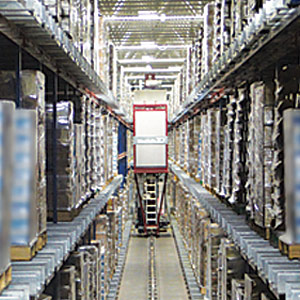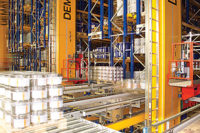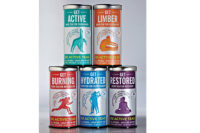
|
| Westfalia Technologies has the capability to install automated storage and retrieval systems in low bay warehouses to help increase the amount of storage in existing buildings. |
Updating or investing in automation for a warehouse can be a large capital expenditure, but it is an investment that many companies are willing to make. According to the Integrated Systems and Controls Council of the Material Handling Industry of America’s Automation report released earlier this year, “Sentiment Towards Automation Suppliers,” nearly 80 percent of all respondents are planning their first or next automation project.
Of the warehousing, logistics and supply chain managers; engineering, design and technical managers; corporate and executive managers; operations, production and plant managers; facilities managers; and purchasing employees polled, nearly one-third are planning to start a project in the next six months, while roughly 60 percent expect to begin a project within a year, the report states. Slightly less than half of respondents reported that their last project was completed within the last six months, it adds.
To help address storage as well as product handling, companies are turning to automated storage and retrieval systems (AS/RS) to help automate their warehouses. Lonnie Watkins, strategic account manager of integrated systems with Dematic North America, Grand Rapids, Mich., says the company designs systems to do work throughout a warehouse, typically in a pallet handling system, but that type of system can require a certain amount of scale.
“Scale is good for us; the smaller you are, the more difficult it is to justify higher levels of automation and especially AS/RS because we’ve got a lot of equipment that takes some decent capital investment, so you need to make sure that you’ve got enough velocity through the facility to justify this or any other kind of automation,” he says.
Watkins adds that Dematic has seen some clients with a significant level of inventory storage requirements receive a return-on-investment (ROI) between two and five years.
In addition to scale, companies also are tasked with dealing with the limitations of their storage spaces. Westfalia Technologies, York, Pa., can install a high-density AS/RS in existing low bay warehouses. Jon Schultz, vice president of business development for Westfalia, says there is an excess of existing low bay buildings, and installing an AS/RS can address the issue of storage in those buildings.
“What we’re finding is in a beverage or food situation, we can typically double and sometimes even triple the amount of product they store in their existing building,” he says. “If [companies] came out and said, ‘I need twice as much storage as I have now,’ we can do that without building any new buildings whatsoever, just by automating and [adding depth to] their current storage.”
Schultz says that automating an existing building can provide a better value all around than looking at new construction or high-rise construction. “The operational cost, whether you go high-rise or low-rise, doesn’t change. We save just as much money,” he says. “The beauty of it in a low-rise is we’re doing it for less capital, so in the end it’s a better value all around. We’re saving the operational costs … but we’re doing it for less investment upfront, which is why it’s so attractive right now.”
Growing variety
As beverage distributors add more products and brands to their warehouses, they are now met with the challenge of an expanding portfolio. “There’s more SKUs; people want more sales,” says Bill Leber, director of business development and marketing for Swisslog, Newport News, Va. “The overall market is stagnant, but it’s sort of changing in that the total volume of beverage isn’t going anywhere, but the variety in beverage keeps increasing, so it makes it more difficult to justify only pallets.”
Dematic’s Watkins says SKU proliferation is one of the most visible trends taking place in the beverage industry that is impacting AS/RS.
“We have wholesalers that maybe five or six years ago had a couple hundred products that are now in the 2,000 product range, so their ability to handle that from a processing perspective and getting product to the streets has become more complicated, and in many ways we can support that activity with our automation,” he says.
Watkins adds that within Dematic’s AS/RS models, it has solutions and software that can support tasks from pallet handling to layer handling to bin handling, even down to a case level perspective.
Coupled with a growing number of SKUs, suppliers are providing solutions for distributors to add layer picking for more mixed pallets. Leber says retailers no longer are ordering full pallets of a single product. Instead, they might want three or four different products on the pallet. “An automated layer picker can quickly configure that pallet with very little labor,” he says.
Safe, efficient future
As with many operations in the supply chain, AS/RS configurations also understand the importance of safety. Dematic’s Watkins says the company has a commitment to quality components, products and a heavy focus on training in terms of both operations and maintenance to communicate about safety.
To address safety concerns in storage and retrieval machines, Westfalia developed an employee lift cabin earlier this year, which is independent from the vertical pallet lift and its load-carrying device. The lift cabin is able to transport one person up the mast of the crane to avoid the practice of climbing up and down service ladders.
Available in two models, the lift cabin comes as a regular cabin with controls put in dead man’s mode and another that operates through a mobile control panel.
“We bring the safety needs of our customers to the forefront with our new technology,” explains Dan Labell, Westfalia’s president. “Placing a moveable independent cabin on the storage and retrieval machine provides additional safety and comfort for personnel operating and maintaining an automated warehousing system.”
In addition to safety, Westfalia also has been busy developing software to aid in the efficiency of AS/RS practices. The company released Savanna.NET Warehouse Management Software version 2.3 this year. The features of Savanna’s latest model include real time three-dimensional visualization of the warehouse; a dashboard for tracking key statistics of warehouse operations; streamlined user rights management interfaces; and improvements to the order picking module for integrating third-party picking solutions such as high-speed layer picking and mixed layer picking.
Suppliers also are seeing new ways to address automation within warehouses for beverage operations. Swisslog’s Leber foresees shuttle systems, which are used in other industries, to become a part of the beverage operations landscape.
“Shuttle systems are a type of automated storage and retrieval [system] where instead of moving full pallets, you’re now handling and storing cases individually or maybe in twos or fours,” he says. “[They] are becoming a hot topic and as shuttle systems get introduced, they’re going to go down the learning curve. Costs will come down and it’s only a matter of time before they start getting used in beverage [applications].”
Swisslog recently previewed its newest generation shuttle system, SmartCarrier, in the North American market. Goods are presented at ergonomic goods-to-person picking stations either directly, by shuttle vehicles or connecting conveyors, the company says. SmartCarrier will be formally released to the general North American market at MODEX in February 2012.
Dematic also recently released a new shuttle system. Its Generation II Multishuttle will provide a lighter, faster and more economical machine for the Multishuttle case handling market, Watkins says. Designed to enhance the interface between bulk stock and functions like picking, order assembly and sequencing, the Dematic Multishuttle increases speed, accuracy and throughput, the company says. BI






